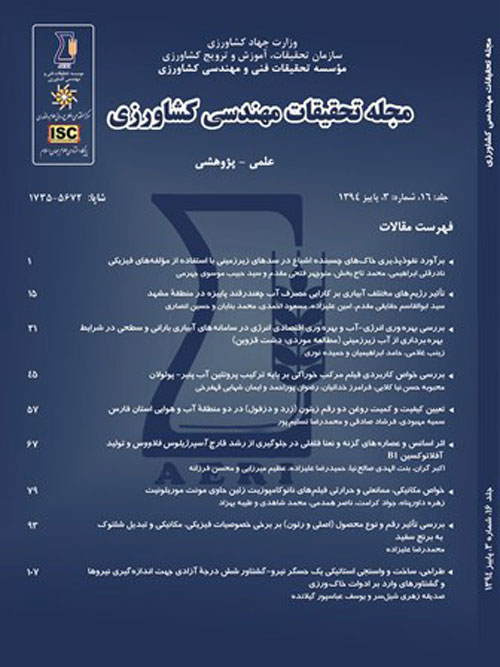Distribution Uniformity of Water and Nitrogen in Sugarcane Furrow Fertigation
Author(s):
Abstract:
This research investigated the effects of fertigation on the uniformity of distribution of water and nitrogen for furrow irrigation and compared them to the results of field measurements from Abbasi et al. model output. This large-scale experiment was carried out as once-split plots in a randomized complete block design with three replications over 25 ha2 of newly-planted sugarcane planted by Dehkhoda Sugarcane Agro-Industry from February 2012 to October 2013. The main factor was split application of fertilizer (1, 2, or 3 applications during the growing season). The secondary factor was fertilizer application level at 100% (350 kg urea), 80% (280 kg urea), and 60% (210 kg urea) of fertilizer requirements. The coefficients for the Kostiakov infiltration equation were derived using the volumetric balance model. The Abbasi et al. fertigation model was implemented to simulate water flow and nitrate transport in soil. Fertilizer injection time was 30% to 60% of total irrigation time. Proper management of the inlet discharge and appropriate selection of fertilizer application times and frequencies increased distribution uniformity for the water and fertilizer. The E statistical index was greater than 0.990 for all fertigation treatments, indicating good performance of the model for prediction of advance and recession times. Comparison of the means for advance and recession times using the t-test showed that t < 2.447 (critical t) for all treatments, indicating good performance of the model. The t-test for discharge and uniformity coefficients for water and fertilizer showed that t > 2.305 (critical t), which suggests that flow rate had a significant effect on water and fertilizer distribution uniformity. The Abbasi et al. model improved water use efficiency and fertilizer distribution uniformity by optimizing the model inputs for infiltration parameters, inflow rate, and field slope. The results of field measurements and model prediction were more similar to the last fertilizer application times than to other treatments. The discrepancy of infiltrated water depths obtained from both methods was about 2 mm for the 4-application treatment with the 60% fertilizer level during the 11th irrigation and the 3-application treatment with the 100% fertilizer level during the 10th irrigation treatment. For these treatments, distribution uniformity of fertilizer increased more than did water distribution uniformity (> 90%).
Keywords:
Language:
Persian
Published:
Journal of Agricultural Engineering Research, Volume:16 Issue: 2, 2015
Pages:
41 to 60
magiran.com/p1441626
دانلود و مطالعه متن این مقاله با یکی از روشهای زیر امکان پذیر است:
اشتراک شخصی
با عضویت و پرداخت آنلاین حق اشتراک یکساله به مبلغ 1,390,000ريال میتوانید 70 عنوان مطلب دانلود کنید!
اشتراک سازمانی
به کتابخانه دانشگاه یا محل کار خود پیشنهاد کنید تا اشتراک سازمانی این پایگاه را برای دسترسی نامحدود همه کاربران به متن مطالب تهیه نمایند!
توجه!
- حق عضویت دریافتی صرف حمایت از نشریات عضو و نگهداری، تکمیل و توسعه مگیران میشود.
- پرداخت حق اشتراک و دانلود مقالات اجازه بازنشر آن در سایر رسانههای چاپی و دیجیتال را به کاربر نمیدهد.
In order to view content subscription is required
Personal subscription
Subscribe magiran.com for 70 € euros via PayPal and download 70 articles during a year.
Organization subscription
Please contact us to subscribe your university or library for unlimited access!



